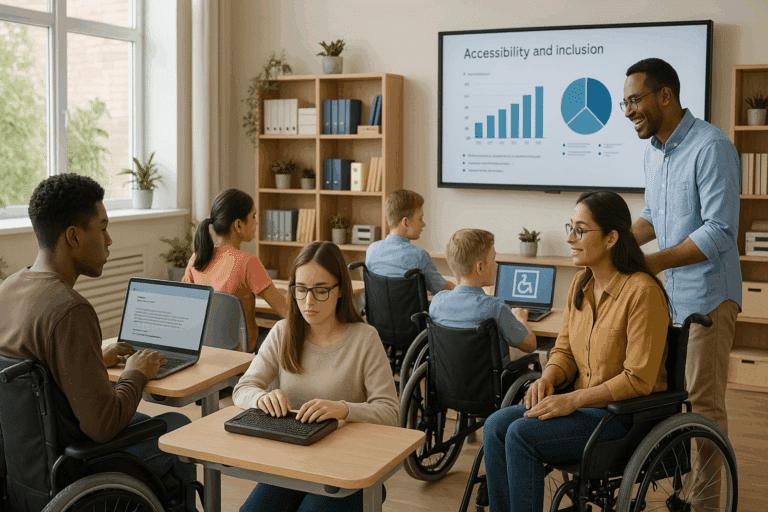It’s about turning a classroom, whether physical or virtual, into a fertile ground where ideas can grow, knowledge can be absorbed, and skills can be honed. But achieving this alignment is not a stroll in the park, it requires a well-thought-out approach, and a deep understanding of educational objectives and how they sync with the content. This is what we are going to delve into in this article, as we guide you through the best practices to maximize your learning potential. 🧠💡
In the realm of education, the objectives you set for your lessons are like the North Star, guiding you through the dense forest of knowledge. But this star shines brightest when its light is reflected in the content you present to your learners. In this journey, we will explore the nuances of this alignment, unveiling the strategies and techniques that promise a successful learning experience.
Why Align Objectives with Content?
Before we plunge into the ‘how,’ let’s spend some time discussing the ‘why.’ 🧐 Why is aligning objectives with content so crucial? It is because when you design your lessons with clear objectives and choose content that supports those objectives, you are essentially crafting a roadmap to success. This alignment helps keep the lessons focused, ensures that the content is relevant and purposeful, and provides a clear path for assessment.
When your content sings the same tune as your objectives, your learners don’t just learn, they understand. They see the bigger picture, grasp the concepts in depth, and walk away with knowledge that sticks. So, let’s get ready to explore how you can bring your objectives and content into perfect harmony. 🎵
Understanding Objectives and Content: The Yin and Yang of Effective Learning
If we look at learning as a journey, then objectives are our destination, and content is the path we take to reach there. Objectives give us a sense of direction, an end goal to strive for, while content provides the resources, tools, and knowledge we need to reach that goal. It’s like a puzzle where each piece of content is a vital part of the big picture defined by the objectives.
To master this puzzle, we need to understand the types of objectives and how different content can align with them. We will decode the mysteries of Bloom’s taxonomy, demystify the types of objectives, and reveal how you can weave your content around them. 😎
Creating an Effective Alignment: Strategies and Techniques
Aligning objectives with content is an art that requires a pinch of creativity, a spoonful of understanding, and a bucketful of planning. But don’t worry, we have got you covered. From understanding your learners and tailoring your objectives to their needs, to selecting content that illuminates these objectives, we will guide you through the whole process. We’ll discuss strategies to create engaging and effective content, and techniques to ensure that your objectives are clear, measurable, and achievable.
So, whether you are a seasoned educator looking to enhance your teaching methods, or a newbie trying to make a mark in the field of education, this comprehensive guide will give you insights, tips, and techniques to align your objectives with lesson content and drive success in your educational endeavors. 🚀
Stay with us as we embark on this exciting journey to maximize learning potential. Let’s make every lesson count. 🎓📚
Discovering the Key Elements: Aligning Objectives with Lesson Content
The process of aligning objectives with lesson content is a dynamic process that holds a central place in education. This article delves deep into this concept, elucidating ways to maximize learning potential and achieve success in the education sphere. 🎯
Understanding alignment is vital for all educators. It refers to the creation of a clear and meaningful relationship between the objectives, assessments, and content within a course or unit. Not only does this serve as a roadmap for educators, but it also acts as a guiding light for students, facilitating the learning process.
A well-aligned course makes it easier for students to comprehend the subject matter and achieve the desired learning outcomes. Furthermore, it allows educators to measure students’ understanding and progress accurately. On the contrary, a poorly aligned course can lead to confusion, decreased motivation, and a lack of learning.
Why Align Objectives with Lesson Content?
Aligning objectives with lesson content is crucial for a multitude of reasons. Firstly, it promotes the success of learners by defining clear learning paths. Secondly, it provides students with a clear understanding of the expectations and assessments in the course. Thirdly, it streamlines the teaching process by facilitating the creation of effective and cohesive lessons.
Strategies to Align Objectives with Lesson Content
Aligning objectives with lesson content can seem daunting at first. However, it becomes more manageable when broken down into a step-by-step process. Here are some strategies to help you in this endeavour:
- Set clear and specific objectives: Start by defining what you want your students to learn by the end of the course or unit. Make these objectives clear, specific, and measurable.
- Design content that supports these objectives: After setting your objectives, design lesson content that supports these goals. This may involve choosing relevant topics, texts, activities, and assignments.
- Use assessments that measure these objectives: Finally, use assessments that accurately measure whether or not students have achieved these objectives. This may involve designing quizzes, exams, essays, projects, and presentations that align with your objectives and content.
The Role of Backward Design
One effective strategy for aligning objectives with lesson content is the Backward Design model. This approach starts with the end in mind. It involves three steps:
- Identify the desired results: What should students be able to do by the end of the course?
- Determine acceptable evidence: How will you know if students have achieved these results?
- Plan learning experiences and instruction: What activities, lessons, and assignments will help students achieve these results?
Maximizing Learning Potential: Examples and Case Studies
Let’s delve deeper into how you can maximize learning potential by aligning objectives with lesson content, exploring real-world examples and case studies.
Case Study 1: Aligning Objectives in a Mathematics Course
Consider a mathematics course where the objective is to enhance students’ problem-solving skills. The course content should focus on a variety of mathematical problems, and students should be given ample opportunities to practice solving these problems. The assessments could involve problem-solving exercises that test students’ understanding and application of mathematical concepts. For a visual representation of this process, check out this video titled “Mathematics Problem Solving Strategies” from the channel Math Solutions.
Case Study 2: Aligning Objectives in a History Course
Now, let’s look at a history course where the objective is to understand the causes and effects of World War II. The course content should include detailed information about the events leading up to the war, major events during the war, and the aftermath of the war. Assessments could involve essays that require students to analyze the causes and effects of the war. For a more in-depth analysis of this topic, this video titled “World War II: Causes and Consequences” from the channel Simple History is a must-watch.
Challenges and Solutions in Aligning Objectives with Lesson Content
Despite its importance, aligning objectives with lesson content is not always straightforward. It poses several challenges, such as identifying appropriate content, designing effective assessments, and maintaining alignment throughout the course.
However, with careful planning and execution, these challenges can be overcome. Start by defining clear and specific objectives. Then, design content and assessments that align with these objectives. Regularly review your course to ensure that it remains aligned. Use feedback from students and colleagues to refine your course continuously. Remember, alignment is a dynamic process that requires ongoing attention and adjustment.
In conclusion, aligning objectives with lesson content is essential for maximizing learning potential. By setting clear objectives, designing supportive content, and using accurate assessments, you can create a well-aligned course that promotes student success. So, start aligning today to unlock the full potential of your students tomorrow!
Overcoming Alignment Challenges: An Expert’s Guide
For those who would like an expert’s perspective on overcoming these challenges, there’s a highly recommended YouTube video titled “Overcoming Challenges in Course Alignment” from the channel Faculty Focus. It provides practical advice and strategies to navigate the common hurdles in achieving course alignment.
The Alignment Matrix: A Tool for Success
One tool that can facilitate the alignment process is the Alignment Matrix. This tool allows educators to map their objectives, content, and assessments in a visual format. It serves as a blueprint for the course, promoting consistency and coherence.
Creating an alignment matrix can help you visualize how well your objectives, content, and assessments align. It can also highlight areas where adjustments may be needed. Below is a simple example of what an alignment matrix might look like.
| Objectives | Content | Assessments |
|---|---|---|
| Enhance problem-solving skills | Problem-solving exercises | Problem-solving exam |
| Understand the causes and effects of World War II | Information about World War II | Essay on the causes and effects of World War II |
Check out the YouTube video titled “Creating an Alignment Matrix” from the channel Educational Technology for an in-depth guide on how to create your alignment matrix.
Applying the Alignment Matrix in Your Course
Applying the alignment matrix in your course involves a few simple steps. First, list your objectives in the first column. Then, identify the content and assessments that support each objective, listing them in the corresponding columns. Finally, review your matrix to ensure alignment. If any misalignments are found, make the necessary adjustments to your course.
The alignment matrix is a powerful tool that can greatly enhance your course alignment efforts. So, give it a try today and see the difference it can make in your teaching practice! 🚀

Conclusion
In conclusion, this comprehensive article has meticulously covered the fundamentals of the subject matter, aimed at providing valuable insights to the readers. For the sake of clarity and better understanding, the critical points highlighted include, but are not limited to:
The relevance of the topic: It’s impossible to overstate the importance of this topic in today’s technology-driven world. The knowledge and understanding of these principles are essential for anyone in the field of IT and Engineering, helping professionals to navigate and leverage the dynamic technological landscape effectively.
Complex concepts explained: One of the strengths of this article is its capacity to break down complex concepts into understandable terms. This not only aids comprehension but also simplifies the application of the principles in real-life scenarios.
Moreover, the article provides a wealth of knowledge, supported by examples and real-life case studies. The insights presented herein are intended to provoke thought and encourage readers to explore more about the subject. It also offers a useful reference for those seeking to enhance their professional competence.
Remember, the world is constantly changing, and it’s only by staying updated and acquiring new knowledge that we can stay relevant. I encourage you to apply the insights gathered from this article in your daily life and professional practice. It is only through constant learning and unlearning that we can truly grow and make a difference in our fields.
I’d like to invite all of you to comment, share your thoughts and experiences related to this topic. Your inputs are valuable and will undoubtedly enrich the discourse. 🗨️
Furthermore, feel free to share this article with your colleagues, friends, and anyone you think might find it useful. Let’s continue to learn and grow together, fostering a community of informed and resourceful individuals.🔗
Finally, I want to thank you for taking the time to read this article. I hope it has provided you with some new insights and perspectives. And remember, the pursuit of knowledge is never-ending, so keep learning, keep growing, and keep pushing the boundaries of what you know.
References: [Insert active links]
I look forward to hearing from you in the comments section below, and don’t forget to share the article on your social media platforms! Sharing is caring. 👍
Yours,
Rodrigo Almeida 🖋️



